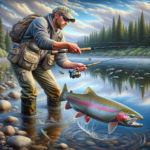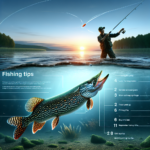Fishing Tips on How to Catch Rainbow Trout

Introduction
Rainbow trout (Oncorhynchus mykiss) are one of the most popular fish species among anglers worldwide. Known for their vibrant colors and spirited fight, these fish are a favorite in sport and recreational fishing. This article aims to provide comprehensive tips on how to catch rainbow trout, covering everything from their physical characteristics and habitats to the best fishing techniques and gear recommendations.
Fish Species Overview
Description
Rainbow trout are easily recognizable by their striking coloration. They typically have a blue-green or olive back, with a pinkish-red stripe running along their sides, and a white underbelly. Their bodies are covered with small black spots. Adult rainbow trout can range in size from 1 to 5 pounds, although larger specimens are not uncommon.
Habitat
Rainbow trout are primarily found in freshwater environments such as rivers, streams, and lakes. They prefer clear, cold waters with abundant oxygen. These fish are native to the Pacific Ocean in Asia and North America but have been introduced to various regions worldwide, including Europe, South America, and Australia.
Behavior
Rainbow trout are opportunistic feeders, consuming a diet that includes insects, crustaceans, and smaller fish. They are most active during the early morning and late evening hours. Spawning typically occurs in the spring when water temperatures range between 42°F and 52°F. Anglers often face challenges such as the trout’s wariness and their preference for specific water conditions.
Best Time to Catch Rainbow Trout
Seasonal Considerations
The optimal time to catch rainbow trout varies by region, but spring and fall are generally the best seasons. During these times, water temperatures are ideal, and the fish are more active and feeding aggressively.
Time of Day
Rainbow trout are most active during the early morning and late evening. These periods offer lower light conditions, which make the fish feel more secure and willing to feed.
Weather Conditions
Ideal weather conditions for catching rainbow trout include overcast days with calm waters. Cloudy skies reduce light penetration, making the fish less wary. Additionally, light rain can stimulate feeding activity by washing insects into the water.
Top Fishing Techniques for Rainbow Trout
Fly Fishing
Fly fishing is one of the most effective techniques for catching rainbow trout. This method involves using artificial flies that mimic the insects trout feed on. Fly fishing is particularly effective in rivers and streams where trout are actively feeding on the surface.
Spin Fishing
Spin fishing with lures such as spinners, spoons, and small crankbaits is another popular technique. These lures mimic the movement of small fish or insects, enticing trout to strike. Spin fishing is versatile and can be used in both still and moving waters.
Bait Fishing
Bait fishing with live or natural baits like worms, minnows, or salmon eggs can be highly effective, especially in lakes and ponds. This technique is straightforward and can be particularly useful for beginners.
Pro Tips
- Use light tackle to increase sensitivity and improve your chances of detecting bites.
- Match the hatch by using flies or lures that resemble the local insect population.
- Vary your retrieval speed and pattern to find what triggers strikes.
Recommended Gear for Catching Rainbow Trout
Fishing Rod and Reel
A medium-light to medium-action rod paired with a spinning reel is ideal for rainbow trout. For fly fishing, a 4 to 6-weight rod with a matching reel is recommended.
Fishing Line
For spin fishing, use a 4 to 8-pound test monofilament or fluorocarbon line. Fly anglers should use a floating line with a tapered leader.
Hooks and Baits
Use size 8 to 12 hooks for bait fishing. Effective baits include worms, minnows, and salmon eggs. For artificial lures, spinners, spoons, and small crankbaits work well.
Additional Gear
- Bobbers: Useful for keeping bait at the desired depth.
- Sinkers: Help to cast further and keep bait near the bottom.
- Leaders: Protect against sharp teeth and improve bait presentation.
Best Locations to Find Rainbow Trout
General Locations
Rainbow trout are commonly found in clear, cold freshwater bodies such as rivers, streams, and lakes. They prefer areas with abundant cover, such as submerged logs, rocks, and vegetation.
Specific Regions
Popular regions for rainbow trout fishing include the Pacific Northwest, the Great Lakes, and the Rocky Mountains in North America. Internationally, New Zealand, Chile, and parts of Europe are renowned for their rainbow trout fisheries.
Common Mistakes to Avoid
Using the Wrong Gear
Using gear that is too heavy can reduce sensitivity and make it harder to detect bites. Opt for lighter tackle to improve your chances of success.
Ignoring Local Insect Activity
Failing to match the hatch can result in fewer bites. Pay attention to the local insect population and choose flies or lures that closely resemble them.
Fishing at the Wrong Time
Fishing during the heat of the day when trout are less active can be unproductive. Focus your efforts on early morning and late evening for the best results.
Catch and Release Tips
Importance of Conservation
Practicing catch and release helps to maintain healthy fish populations and ensures that future generations can enjoy the sport. Ethical fishing practices are crucial for conservation.
Proper Handling Techniques
- Use wet hands or a wet cloth to handle the fish, reducing the risk of removing their protective slime coat.
- Avoid keeping the fish out of the water for more than a few seconds.
- Use barbless hooks to make release easier and less stressful for the fish.
Legal Considerations
Be aware of local regulations regarding size limits, bag limits, and protected areas. Always follow these rules to ensure sustainable fishing practices.
Frequently Asked Questions (FAQs)
What is the best bait for catching rainbow trout?
The best bait for rainbow trout varies by season and location. Common natural baits include worms, minnows, and salmon eggs. Artificial lures such as spinners, spoons, and flies are also effective.
Where is the best place to fish for rainbow trout?
Rainbow trout are commonly found in clear, cold freshwater bodies such as rivers, streams, and lakes. Popular fishing spots include the Pacific Northwest, the Great Lakes, and the Rocky Mountains.
What time of day is best for catching rainbow trout?
The best time of day to catch rainbow trout is during the early morning and late evening when they are most active. Overcast days can also improve your chances.
What type of fishing line should I use for rainbow trout?
For spin fishing, a 4 to 8-pound test monofilament or fluorocarbon line is recommended. Fly anglers should use a floating line with a tapered leader.
Do I need a special fishing license to catch rainbow trout?
Yes, a fishing license is typically required to catch rainbow trout. Check local regulations for specific licensing requirements, size limits, and bag limits.
What is the best technique for catching rainbow trout?
Fly fishing, spin fishing with lures, and bait fishing with natural baits are all effective techniques for catching rainbow trout. The best method depends on the specific conditions and your personal preference.
Are there any specific weather conditions that improve the chances of catching rainbow trout?
Overcast days with calm waters are ideal for catching rainbow trout. Light rain can also stimulate feeding activity by washing insects into the water.
Can I catch rainbow trout from the shore, or do I need a boat?
Rainbow trout can be effectively caught from both shore and boat. Shore fishing is often productive in rivers and streams, while a boat can provide access to deeper areas in lakes.
How can I improve my chances of landing a big rainbow trout?
To catch larger rainbow trout, use larger baits or lures, fish during low-light conditions, and target deeper waters where bigger fish are likely to be found.
What should I do if I plan to release rainbow trout after catching them?
Practice ethical catch and release by using wet hands to handle the fish, minimizing the time out of water, and using barbless hooks. Follow local regulations to ensure the fish’s survival.
Conclusion
Rainbow trout are a rewarding species to target for anglers of all skill levels. By understanding their behavior, choosing the right gear, and employing effective fishing techniques, you can increase your chances of success. Remember to practice ethical fishing and conservation to ensure that these beautiful fish remain abundant for future generations. Happy fishing!




